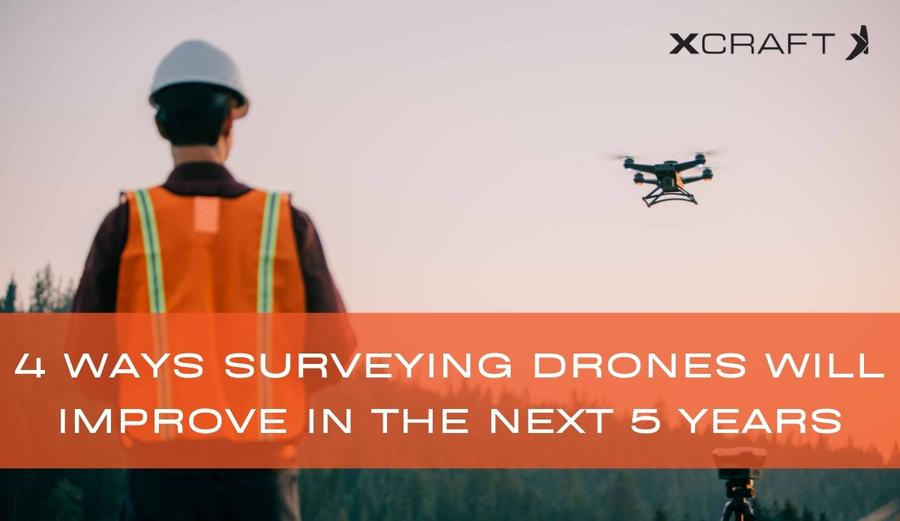In just a few years, drone technology has gone from esoteric niche applications to mainstream use in a number of industries, and one of the applications that has proven ideal for drone use is surveying and mapping.
Surveying drones equipped with precise GPS tracking, high resolution cameras, pre-programmable route tracking, and software interfaces that provide orthomosaic mapping capability all make drone surveying superior to traditional surveying methods, particularly when it comes to difficult terrain. Add to these features the fact that drones can complete surveys quickly and safely, and can be re-deployed repeatedly gives them a distinct edge over their human counterparts.
Nevertheless, as with all things technological, there is still room for improvement, and, at xCraft, we anticipate that surveying drones will make considerable gains in the next five years. Here are some of the exciting trends to keep an eye on.
1. Better Batteries
Flight times for drones of all kinds have been on a steady upwards trajectory for the past few years, and we expect this trend to continue. Drones, especially, will benefit from general advancements in battery technology. Right now, the push to innovate by developing batteries that are smaller, lighter, and with extended life is largely being driven by EV manufacturers hoping to extend vehicle range. But developments in that industrial sector will undoubtedly mean that drone batteries will achieve similar gains.
Better, lighter, more powerful batteries means longer run-time for drones before having to replace or recharge batteries. This means your surveying drone or agriculture drone can cover a lot more acreage on a given charge. It also means that a drone can carry larger payloads, giving it additional capabilities and features. Right now, our Nano One, for example, flies 31 minutes but boasts thermal cameras and much stronger motors to combat adverse weather conditions. Increased battery life and payload capacity will increase the utility of this drone for additional applications.
2. Better Image Composition
Right now, UAVs can put out high-quality video footage and still imagery exceeding 4k resolution. Nevertheless, for surveying operations, software interfaces are needed to “stitch” these images together to create useful large-scale images and to craft 3D renderings of scanned areas. Sometimes, these images can take a long time to create and may look a bit “patchy.” So even though the current images and models are still more accurate, useful, and affordable than what could be put together prior to the use of drones, as algorithms improve, we’ll see faster and better orthomosaic imaging. In fact, one of the reasons we know this will improve in the next five years is that xCraft has been working on our own software to achieve precisely these results.
3. Improved Accuracy
Accuracy is about more than resolution. While camera sensors will continue to shrink and enable higher resolution imaging on small form factor drones, that’s not the only way to improve accuracy. Improvements in RTK and PPK technology, which enable drones to pinpoint the images they record to their precise GPS location, will ensure that mapping is even more geographically accurate. As drone components shrink, we’ll be able to add more technologies to the same drone. By getting multiple sources of information, including thermal, LiDAR, geolocation, and hi-resolution camera footage, you’ll be able to create highly accurate reproductions and models of surveyed areas. That means that a state-of-the-art surveying drone like xCraft’s Matrix RTK can collect extremely detailed information about surveyed areas that go far beyond the visual.
Coupled with software-based AI enhancements, you’ll not only have more accurate imaging, but if you can enhance the ability of software to recognize features, you can improve the imaging and modeling output of drone surveys with automatic object labeling, topographical elevation labeling, precise geolocation, and other data quickly and accurately.
4. Increased Ease of Use
Even now, UAVs are relatively easy to pilot. Using tablets for control and with some training on fundamentals, pilots can now perform a lot of functions with their drones. But as the drones and the software interfaces they employ become more sophisticated, you can probably expect that drones will do more functions with less pilot control and input. Automation is constantly improving. You’ll be able to program flights down to the centimeter and even queue up multiple flights, allowing drones to operate virtually autonomously. And with GPS docks and recharging stations, you could send your drone out to do multiple tasks, relying on smart technology to program the UAV to fly back and recharge as needed, working 24/7 or on any other schedule you create.
Upgrade Your Drones
While we are excited about technological developments that will change the complexion of the UAV industry, the fact is, at xCraft, we’re building the drones of the future today, right here in the USA. Contact xCraft today to learn more about our surveying drone solutions for both industrial and military applications.


